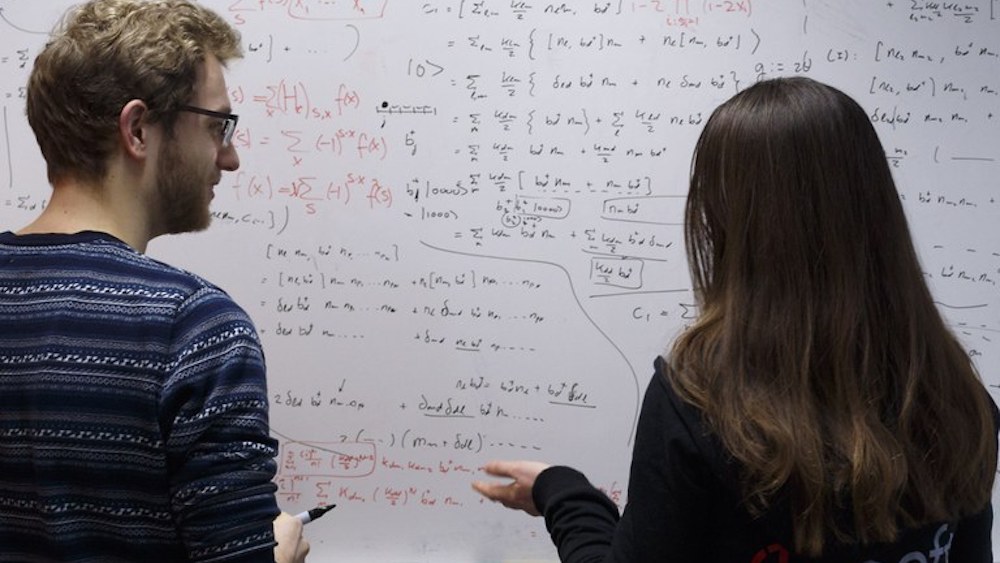
New protocols can speed up near-term quantum computers Koen Groenland from CWI developed protocols for near-term, few qubit quantum computers. Here he discusses the physics of quantum computers with fellow researcher Yfke Dulek. Picture: Bob Bronshoff.
CWI researcher Koen Groenland developed methods to do so, by replacing a long series of calculations by one fast single step that engages many quantum bits at the same time, using advanced mathematics and physics. He defends his PhD thesis ‘Quantum protocols for few-qubit devices ’ at the University of Amsterdam on 17 January. His results can help improve early quantum computers.
"It is an exciting time for quantum computers right now", Groenland says. "The fast development of quantum hardware has brought us to the point where quantum computers can almost compete with conventional computers on specific problems. Scientists can't wait to test the first the first algorithms on these computers, for example to better understand chemical reactions or to develop new drugs." Still, the quantum computers that will be available in the next couple of years will probably be very limited, as they can store only a few tens to a few hundred bits of information, and can withstand only a small number of computational steps before the memory is obscured by noise. Groenland designed new quantum protocols that use the physics of the hardware to construct bigger building blocks of algorithms. He hopes that this allows early computers to perform calculations that would otherwise take too long.
Inspiration for these techniques was derived from the physics of materials. Groenland: "Many quantum computers consist of atoms that are pinned in place at a fixed location, similar to how atoms arrange in a crystal structure in a solid material. Thanks to a wealth of results from the physics of solids, we can also understand how quantum computers behave when multiple qubits interact. One example is the use of resonance in quantum systems, where the use of laser light with the correct frequency can cause atoms to quickly change into a different state. This is precisely what is needed to obtain a useful quantum operation."
Groenland did his research in the Algorithms and Complexity research group at Centrum Wiskunde & Informatica (CWI) in Amsterdam, the national research institute for mathematics and computer science in the Netherlands, which is part of the Institutes Organisation of NWO, the Dutch Research Council. Groenland's promotores are Prof. Harry Buhrman (CWI and UvA) and Prof. Kareljan Schoutens (UvA). Groenland was also affiliated with QuSoft (the Dutch research center for quantum software) and with the UvA’s Institute of Physics.
"It is an exciting time for quantum computers right now", Groenland says. "The fast development of quantum hardware has brought us to the point where quantum computers can almost compete with conventional computers on specific problems. Scientists can't wait to test the first the first algorithms on these computers, for example to better understand chemical reactions or to develop new drugs." Still, the quantum computers that will be available in the next couple of years will probably be very limited, as they can store only a few tens to a few hundred bits of information, and can withstand only a small number of computational steps before the memory is obscured by noise. Groenland designed new quantum protocols that use the physics of the hardware to construct bigger building blocks of algorithms. He hopes that this allows early computers to perform calculations that would otherwise take too long.
Inspiration for these techniques was derived from the physics of materials. Groenland: "Many quantum computers consist of atoms that are pinned in place at a fixed location, similar to how atoms arrange in a crystal structure in a solid material. Thanks to a wealth of results from the physics of solids, we can also understand how quantum computers behave when multiple qubits interact. One example is the use of resonance in quantum systems, where the use of laser light with the correct frequency can cause atoms to quickly change into a different state. This is precisely what is needed to obtain a useful quantum operation."
Groenland did his research in the Algorithms and Complexity research group at Centrum Wiskunde & Informatica (CWI) in Amsterdam, the national research institute for mathematics and computer science in the Netherlands, which is part of the Institutes Organisation of NWO, the Dutch Research Council. Groenland's promotores are Prof. Harry Buhrman (CWI and UvA) and Prof. Kareljan Schoutens (UvA). Groenland was also affiliated with QuSoft (the Dutch research center for quantum software) and with the UvA’s Institute of Physics.




 IonQ Achieves Industry Leading Performance on Next Generation Barium Qubits
IonQ Achieves Industry Leading Performance on Next Generation Barium Qubits